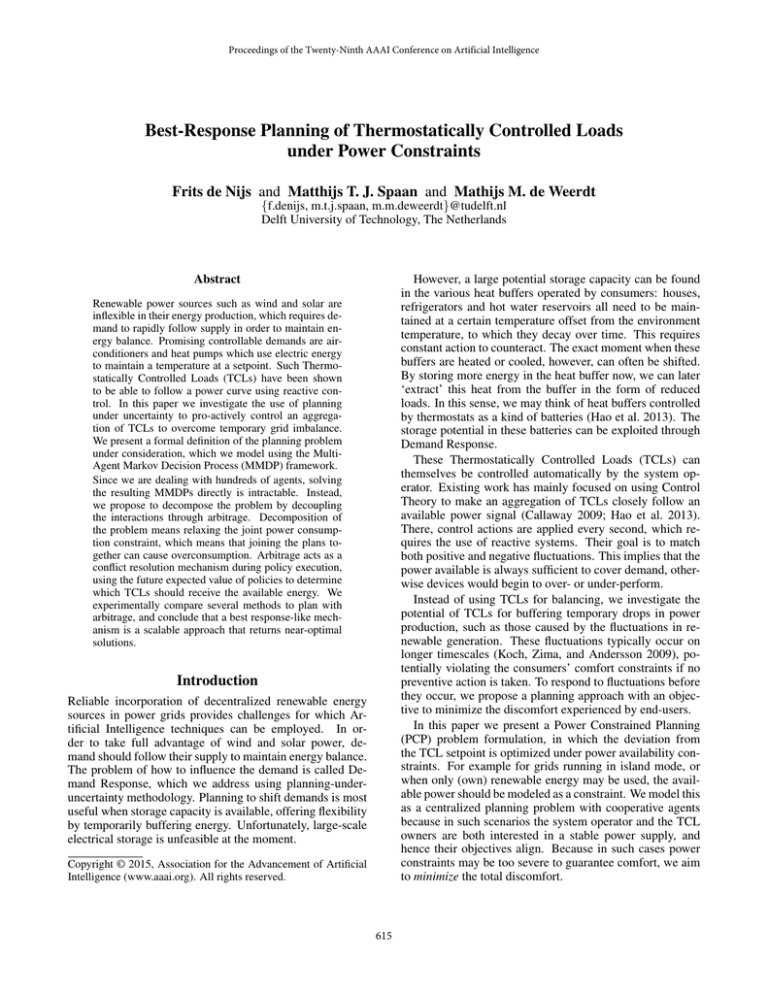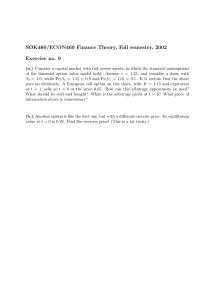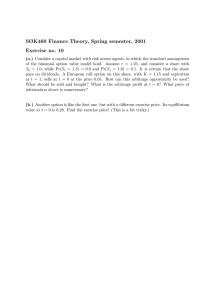
Proceedings of the Twenty-Ninth AAAI Conference on Artificial Intelligence
Best-Response Planning of Thermostatically Controlled Loads
under Power Constraints
Frits de Nijs and Matthijs T. J. Spaan and Mathijs M. de Weerdt
{f.denijs, m.t.j.spaan, m.m.deweerdt}@tudelft.nl
Delft University of Technology, The Netherlands
Abstract
However, a large potential storage capacity can be found
in the various heat buffers operated by consumers: houses,
refrigerators and hot water reservoirs all need to be maintained at a certain temperature offset from the environment
temperature, to which they decay over time. This requires
constant action to counteract. The exact moment when these
buffers are heated or cooled, however, can often be shifted.
By storing more energy in the heat buffer now, we can later
‘extract’ this heat from the buffer in the form of reduced
loads. In this sense, we may think of heat buffers controlled
by thermostats as a kind of batteries (Hao et al. 2013). The
storage potential in these batteries can be exploited through
Demand Response.
These Thermostatically Controlled Loads (TCLs) can
themselves be controlled automatically by the system operator. Existing work has mainly focused on using Control
Theory to make an aggregation of TCLs closely follow an
available power signal (Callaway 2009; Hao et al. 2013).
There, control actions are applied every second, which requires the use of reactive systems. Their goal is to match
both positive and negative fluctuations. This implies that the
power available is always sufficient to cover demand, otherwise devices would begin to over- or under-perform.
Instead of using TCLs for balancing, we investigate the
potential of TCLs for buffering temporary drops in power
production, such as those caused by the fluctuations in renewable generation. These fluctuations typically occur on
longer timescales (Koch, Zima, and Andersson 2009), potentially violating the consumers’ comfort constraints if no
preventive action is taken. To respond to fluctuations before
they occur, we propose a planning approach with an objective to minimize the discomfort experienced by end-users.
In this paper we present a Power Constrained Planning
(PCP) problem formulation, in which the deviation from
the TCL setpoint is optimized under power availability constraints. For example for grids running in island mode, or
when only (own) renewable energy may be used, the available power should be modeled as a constraint. We model this
as a centralized planning problem with cooperative agents
because in such scenarios the system operator and the TCL
owners are both interested in a stable power supply, and
hence their objectives align. Because in such cases power
constraints may be too severe to guarantee comfort, we aim
to minimize the total discomfort.
Renewable power sources such as wind and solar are
inflexible in their energy production, which requires demand to rapidly follow supply in order to maintain energy balance. Promising controllable demands are airconditioners and heat pumps which use electric energy
to maintain a temperature at a setpoint. Such Thermostatically Controlled Loads (TCLs) have been shown
to be able to follow a power curve using reactive control. In this paper we investigate the use of planning
under uncertainty to pro-actively control an aggregation of TCLs to overcome temporary grid imbalance.
We present a formal definition of the planning problem
under consideration, which we model using the MultiAgent Markov Decision Process (MMDP) framework.
Since we are dealing with hundreds of agents, solving
the resulting MMDPs directly is intractable. Instead,
we propose to decompose the problem by decoupling
the interactions through arbitrage. Decomposition of
the problem means relaxing the joint power consumption constraint, which means that joining the plans together can cause overconsumption. Arbitrage acts as a
conflict resolution mechanism during policy execution,
using the future expected value of policies to determine
which TCLs should receive the available energy. We
experimentally compare several methods to plan with
arbitrage, and conclude that a best response-like mechanism is a scalable approach that returns near-optimal
solutions.
Introduction
Reliable incorporation of decentralized renewable energy
sources in power grids provides challenges for which Artificial Intelligence techniques can be employed. In order to take full advantage of wind and solar power, demand should follow their supply to maintain energy balance.
The problem of how to influence the demand is called Demand Response, which we address using planning-underuncertainty methodology. Planning to shift demands is most
useful when storage capacity is available, offering flexibility
by temporarily buffering energy. Unfortunately, large-scale
electrical storage is unfeasible at the moment.
Copyright © 2015, Association for the Advancement of Artificial
Intelligence (www.aaai.org). All rights reserved.
615
using the Hadamard product b = a ◦ θt =⇒ bi = ai ×
θi,t ∀i, we can define a state transition function to compute
θt+1 as
f (θt , mt , θtout ) = a ◦ θt + (1 − a) ◦ θtout + mt ◦ θ pwr .
(2)
rnd
For simplicity, we keep random factor θi,t
set to 0 for the
planning phase, because we focus on distributions with expected value 0, and so that we can produce simpler optimal
formulations.
With this function, we can define a planning problem
using a given horizon h, the thermal properties of the n
thermostatic loads with initial temperatures θ0 , the predicted outdoor temperature θtout , and the predicted power
constraint Lt . A solution is a device activation schedule that
never switches on more devices than is allowed while minimizing cost function c(θt ). The entire planning problem
becomes:
In order to solve the PCP problem, we model it as a
Multi-agent Markov Decision Process (MMDP) (Boutilier
1996), in which each TCL is represented by an agent. However, as we are considering neighborhoods with hundreds
of households, naively solving the resulting exponentiallysized MMDP will not suffice. In this paper, we show how
we can exploit the fact that the only interaction among the
agents is the allocation of available power. We decouple the
problem and let each agent compute its own individual plan
using a single-agent MDP. Combining the individual plans
will result in a joint plan that might not be feasible due to
power constraints. Hence, we introduce an arbitrage mechanism that ensures power constraints are respected by limiting the number of TCLs that can be switched on simultaneously. However, by in turn computing best-response policies
and by learning the probability of being allowed to switch
on, we compute scalable and effective solutions to the PCP
problem.
We perform experiments on a small toy problem and on
a larger test scenario. The toy problem allows us to clearly
illustrate our ideas and to showcase the limited scalability
of optimal centralized solutions. Using the larger scenario,
we show that the best-response policies are able to scale to
realistic problem sizes, while maintaining a solution quality
that is near optimal.
h−1
X
minimize
[ m0 m1 ··· mh−1 ]
c(θt )
t=0
subject to θt+1 = f (θt , mt , θtout )
n
X
mi,t ≤ Lt
(3)
i=1
Background
mi,t ∈ [0, 1]
A thermostatic load is any device that is able to consume
(electric) power for the heating or cooling of a body in relation to the outdoor temperature, such as refrigerators or central heating systems. The goal of the thermostat is to operate
the device such that the temperature of the body remains as
close as possible to a given setpoint at all times.
A Markov chain model of thermostats controlled by hysteresis controllers was presented by Mortensen and Haggerty (1988). In their model, the temperature of the body in
the next time step θi,t+1 is deduced from the current temperature θi,t , the current outside temperature θtout , a temperature input from the device θipwr , and a random temperrnd
ature shift θi,t
modeling exogenous actions such as opening a door. The hysteresis controller operates to keep the
temperature within a deadband surrounding temperature setset
point θi,t
.
We use a similar model in this paper to make on/off decisions mi,t for every TCL i and for every discrete time period t. The length of such a period ∆, together with the
thermal constants Ri (thermal resistance, °C / kW) and Ci
(thermal capacitance, kWh / °C) determine how quickly the
current temperature responds to the external factors through
the fraction ai = exp R−∆
, resulting in the model:
i Ci
rnd
. (1)
θi,t+1 = ai θi,t + (1 − ai ) θtout + mi,t θipwr + θi,t
∀i, t
In this model power consumption is assumed to be constant
within a time step, while in reality start-up transients occur
when devices switch on. However, these occur only for a
couple of seconds, after which consumption is constant, as is
evident from measurements on heat-pump power consumption (van Lumig 2012, pages 25-28). We consider minute
time scales, on which transients do not have a significant
effect.
Due to the generality of the model, the controlled
loads can have different objectives which can be expressed
through the cost function. Besides typical functions such as
Pn
set 2
the squared error c(θt ) = i=1 θi,t − θi,t
or maximum
set
setpoint deviation c(θt ) = maxi θi,t − θi,t
, we might
imagine more application-specific functions. For example,
a refrigerator may only incur high penalties when the temperature gets above a (thawing) threshold.
As a representative example of a cost function we use a
variant of the squared error where minor (0.5 degrees) offsets incur no costs at all:
c(θt ) =
n
X
set max{0, θi,t − θi,t
− 0.5}2 .
(4)
i=1
We use this cost function because it has been shown in user
studies that 90% generally acceptable comfort levels can be
found in a small (2.5°C) band surrounding the ideal temperature (de Dear and Brager 1998). Additionally, it is implementable in mixed-integer programming constraints, and it
imposes an intuitive notion of fairness; if even a single house
is far from its setpoint, a large penalty is still incurred.
Power Constrained Planning
We adapt the unconstrained model from the previous section
into a Power Constrained Planning (PCP) problem. We use
boldface characters to represent vectors of device parameters
over all devices, i.e., θt = [θ1,t θ2,t · · · θn,t ]. Then,
616
Optimal Solutions
function. The joint transition function specifies the cross
product of all agents’ action spaces An . By removing those
actions where the number of agents ‘on’ is more than Lt we
obtain the required constraint.
The resulting MMDP is subsequently solved optimally
using value iteration (Puterman 1994).
To solve the PCP problem optimally, we can encode the formulation from Equation 3 as a mixed-integer program (MIP)
with a minor reformulation.
Pn 2 We introduce new variables ci,t
and let c(θt ) =
i=1 ci,t . To ensure that these variables
represent the correct cost values, we add the following constraints:
ci,t ≥ 0
∀i, t
set
ci,t ≥ θi,t − θi,t
− 0.5
∀i, t
set
ci,t ≥ − θi,t + θi,t
− 0.5
∀i, t
Decoupling, Arbitrage, and Best-Response
The only interaction among the TCLs is the allocation of the
power availability. We therefore introduce a method that exploits this limited level of interaction as follows. First, we
decouple the agents and let them find an individually optimal plan. Then we use an arbitrage mechanism upon execution to make sure that the agents together do not overuse the
available power. Finally, we show how to let the agents coordinate their plans by simulating the arbitrage mechanism
in advance, and performing a best-response to each other’s
policies. Each of these steps is discussed in more detail below.
First we completely decouple the agents, i.e., we factorize the MMDP by discarding the restriction Lt in the joint
transition function. Then we solve a single-agent MDP for
each agent separately.
Second, to overcome the problem that the agents’ plans
are no longer guaranteed to jointly stay within the power
limit, we resolve the conflicts at policy execution using an
arbitrage mechanism: in case too many devices want to
switch on in a certain time step t, we iteratively search for
the agent that expects to lose the least utility from switching off, and switch it off. This is repeated until the conflict
is resolved. To determine which agent expects to lose the
least utility by going from on to off we look at the difference
between the planned utility scores in the value table.
Because this procedure is greedy and deterministic it risks
getting caught in a local minimum. Thus, instead of always
selecting the agent that expects to lose the least utility, we
use the utility loss as a probability of being selected. A
common probability distribution for fairly selecting between
weighted alternatives is the logit equilibrium (McKelvey and
Palfrey 1998).
Third, the plans for the single-agent MDPs take into account the effect of arbitrage and thereby indirectly of the
plans of other agents by estimating how likely an agent is to
be assigned such a constrained action. The following subsection describes how we arrive at good estimates of this
probability.
(5)
Alternatively, the problem can be modeled as a Multiagent Markov decision process (MMDP) (Boutilier 1996).
In our MMDP model we have a set of n agents that all have
the same actions A available to them, and an agent-specific
state S. The transition function T : S n × An × S n → [0, 1]
describes for each joint state and joint action pair (s, t) the
probability of attaining joint state s0 . The agents are cooperating to maximize the collective system reward. Agents are
rewarded for their actions in a certain joint state, through the
reward function R : S n × An → R.
Concretely, we propose the following MMDP model for
the optimization problem defined in Equation 3.
The continuous temperature is discretized into k nonoverlapping states sj each defining a temperature interval
[θsj ,min , θsj ,max ). In addition to this, there are two extrema states smin and smax ranging from (−∞, θs1 ,min ) and
[θsk ,max , ∞) respectively, resulting in the following state
space of an agent: S = {smin , s1 , s2 , . . . , sk , smax } .
Each agent has two actions available to it: A = {off, on}.
The previous action is not part of the state because shortcycling of the devices is already prevented by the sufficient
time between decisions.
The rewards assigned to the agents in each time step are
the costs depending on how large the deviation from the setset
point θi,t
is:
n
X
set − max{0, si − θi,t
− 0.5}2 .
(6)
i=1
The transition function from a state s to a state s0 is derived
by applying the Markov heat-transfer function f (θ, m) =
aθ + (1 − a)(θoutside + mθheating ) to the lower and upper values of the temperature range [θs,min , θs,max ). This produces a
0
0
new range [θmin
, θmax
) that may overlap the ranges of multiple discrete states sj , sj+1 , . . .. The degree of overlap determines the (uniform) probability of transitioning to each of
these potential future states. The factored (per agent) transition function is thus probabilistic, in order to be consistent
with the heat-transfer function:
0
θmin
= f (θs,min , m)
Best-Response Planning for Arbitrage
The first step towards estimating the probability of being assigned energy is to take the pessimistic assumption that everyone always wants to make use of all available energy.
Given this assumption, the probability of being able to activate the TCL is pon (t) = Lnt . This allows agents to detect
potentially congested regions in time, but without knowing
the actual level of congestion.
To estimate the actual demand in congested regions, we
simulate policies computed in an earlier iteration and tally
how much energy is requested. If energy is requested rqon,t
0
θmax
= f (θs,max , m)
0
0
min (θs0 ,max , θmax
) − max (θs0 ,min , θmin
)
T (s, m, s0 ) =
0
0
θmax − θmin
(7)
The imposed power constraint Lt which limits the number
of activated devices is then encoded in the joint transition
617
Pessimistic
Adaptive
Optimal MMDP
Optimal MIP
Devices On
4
3
2
1
Agent
Agent
Agent
Agent
Agent
Temperature (C)
0
21.5
21.0
1
2
3
4
20.5
20.0
19.5
0
5
10
15
0
5
10
15
0
5
10
15
0
5
10
15
Time Step
Figure 1: Activation scheme and agent temperatures in the example instance.
times in iteration i, then in the policy computation for iteration i + 1 we assign probability pon (i, t) = rq Lt , or
on,i−1,t
pon (i, t) = 1 if rqon,i−1,t ≤ Lt .
Additionally, during periods where the expected demand
is higher than the limit on the consumption, agents with a
poor insulation level are much more likely to receive part
of the available power. This is because those are the agents
which incur a large potential error if they are skipped. Thus,
agents that have a high degree of insulation are expected to
make use of it by heating up before a constrained period.
Such agents should learn that they will not receive power
from arbitrage during constrained periods. To learn its relative probability of receiving power, each agent pj counts
rcpj ,on,i,t , the frequency with which his request for energy
is granted in a time step t. Its probability then becomes
rcp ,on,i−1,t
.
pon (pj , i, t) = rq j
such that we know how frequently they need to switch on
in order to keep the temperature within the deadband. In
steady state agents 1 and 2 need to be on 75% of the time,
while agents 3 and 4 need to be on 25% of the time.
We apply optimal MMDP and MIP solvers to this problem (with the MMDP creating plans for 9 distinct temperature states and θmin = 18.5, θmax = 21.5), as well as
the arbitrage decompositions using the Pessimistic probability pon (t) = Lnt , and the decomposition using the Adaprcp ,on,i,t
(using 10 iterations,
tive probability pon (pj , i, t) = rq j
pj ,on,i,t
each with 10 simulations). The plans are subsequently evaluated using the planned decisions applied to the original
continuous temperature function, Equation 1.
Because the optimal MMDP solver relies on a discretization of the temperature state, the level of discretization determines how likely it is to return optimal solution. Similarly,
we expect the decompositions to not generate the optimal
schedules. In particular, the pessimistic scheme is expected
to strongly overheat several of the agents in the first 5 time
steps, expecting heavy congestion in the subsequent middle
10 time steps. In contrast, the adaptive scheme should be
able to detect that during the congested period agents 1 and
2 have much higher probability of switching on, promoting
only agents 3 and 4 to pre-heat, limiting the error.
These expectations can be tested by looking at the cumulative error scores found in Figure 2 and the solutions generated by the four schemes in Figure 1. In Figure 1 we see that
the optimal MIP is indeed able to keep all agents within the
deadband simultaneously. It seems that the optimal MMDP
suffers slightly from the low number of temperature states,
which results in a small error w.r.t. optimal when agent 2
dips below 19.5 degrees in step 14.
Further, while the adaptive scheme stays close to the optimal, it is clear that the pessimistic approach is unable to
find a good schedule. The reason for this can be seen in Figure 1: The second agent needs a lot of energy quickly, and
pj ,on,i−1,t
Experimental Results on Small Instances
In order to demonstrate the value of the decomposition using arbitrage, we perform a number of experiments on small
instances. These experiments are designed to show that:
1. Using individual probability to decompose the MMDP results in near-optimal performance on small instances.
2. Optimal solution methods do not scale beyond a handful
of agents and a short horizon.
To investigate the behavior of the decomposition relative
to the optimal solutions, we develop a toy instance with
hand-crafted parameters resulting in a known optimal solution cost of 0. This instance has 4 agents, a horizon of 20
set
and θi,t
= 20, ∀i, t. In the first 5 time steps, 3 agents are
allowed to switch on, in the next 5 time steps only 2 are allowed, followed by 5 time steps where only 1 is allowed.
The final 5 time steps are unconstrained. Figure 1(top) illustrates the power constraints using black horizontal bars.
Furthermore, the agents have insulation parameters chosen
618
Pessimistic
Adaptive
10
Optimal MMDP
Optimal MIP
0
Solver
Pessimistic
Adaptive
Optimal MMDP
Optimal MIP
10
−1
Runtime (s)
Cumulative Penalty
Solver
10
−2
10
−3
0
5
10
10
2
10
1
10
0
10
−1
15
Time Step
10
−2
Figure 2: Cumulative penalty (log scale) in the example instance.
10
−3
1
2
3
4
Agents
expects it will be unlikely to receive it during the low power
time steps. Therefore it strongly overheats before time 10.
In contrast, the other methods are able to interleave agent 2
between the energy needs of the other agents. Hence, we
conclude that we see all the expected behaviors.
For this small instance, all four considered formulations
are able to return a solution within a reasonable amount of
time (where solving the MMDP took the longest, at 12.5
minutes). However, we expect that the optimal formulations
do not scale well, namely that their solving time grows exponentially with the instance size. On the other hand, the decoupled Pessimistic and Adaptive formulations are expected
to grow in polynomial time, with the Adaptive formulation
taking longer due to the iterative planning and simulation
rounds.
We expect that both the MMDP and the MIP formulations
grow exponentially in time with the number of agents, while
we expect the MIP to additionally have exponential growth
in the length of the horizon. The MMDP does not suffer
from this because the Markovian property allows it to compute decisions iteratively, collapsing the computed decision
sequences into a single expected value.
To evaluate the scalability we constructed a generator that
builds instances which are similar to the example presented
above, but with a variable number of agents and length of the
horizon. We generated instances with the horizon fixed at 20
and the number of agents increasing from 1 to 6, and with
the horizon from 5 to 45 and the number of agents fixed at
3 (10 instances per setting). In addition, we set the MMDP
approach to use only 6 temperature states, and we imposed
a run-time cut-off of 5 minutes. The average run-time performance is shown in Figure 3.
From the figure we can conclude that, indeed, the optimal
methods are not scalable. Both methods appear to have runtime exponential in the number of agents, while the MIP also
seems to have run-time exponential in the horizon.
5
6
10 15 20 25 30 35 40 45
Horizon
Figure 3: Scalability of the optimal and arbitrage methods
for increasing agents and horizon, runtime on log scale.
demonstrate this, in this section we apply it to a simulated
neighborhood of 182 households equipped with heat-pumps.
Their parameters are modeled to match measured performance (van Lumig 2012, page 60).
To determine if the solution quality is near optimal for this
larger instance, we compare the pessimistic and the adaptive
decomposition to a relaxation of the optimal MIP. This relaxation allows the devices to be switched on only partially.
Because devices cannot be switched on partially, and because the decision time step granularity of 1 minute is the
minimum to prevent short-cycling, it is not possible to implement the outcome of the relaxation. However, it is a lower
bound on the optimal solution with binary activations.
In addition to this lower bound, we also compare our results with a hysteresis control solution that operates each
house without look-ahead. For this control method we also
perform arbitrage when required, by switching off units in
order of their current temperature (hottest first).
For the instance, we model a two-day period during which
a gradual decrease of the available power occurs starting
from hour 6. At hour 20 the minimum capacity is reached
and only 10 out of 182 heat pumps are allowed to be
switched on. At the start of the second day, all devices can be
switched on again. The households would all like to mainset
tain an internal temperature of 21 degrees (θi,t
= 21, ∀i, t).
The decision frequency is set to once every minute. While
it is unlikely that in a real-world scenario the power limit
is known with such accuracy, this granularity allows each
unit to switch just in time, and it also serves as a worst-case
problem size to demonstrate scalability. Since the agents are
now decoupled, we can solve the MMDP with much finer
temperature discretization. For the adaptive decomposition
we discretized temperature from 16 to 24 degrees over 80
states, resulting in bins of 0.1 degree width. Computed plans
are again evaluated using the continuous temperature evolution (Equation 1) using a timescale of one second per time
step (thus, a decision is held constant for 60 time steps in the
simulation). Finally, in the simulation procedure the random
component is enabled; for each house in every simulation
Experimental Results on Real-World Instance
In the previous section, we show that the adaptive approach
is able to stay close to the non-scalable optimal solutions
in terms of solution quality. We expect that the adaptive
approach is scalable to the size of typical real-world instances while maintaining near-optimal solution quality. To
619
No Planning
Pessimistic
Solver
where loads are only allowed to be controlled inside their
deadbands, which is unobtrusive to the end-user. Their focus
is on reducing the energy costs of consumers, under the assumption that sufficient power is available to maintain temperature inside the deadbands as required. They do not keep
track of the states of individual devices in the planning and
control phases, which causes a mismatch between their expected and actual performance, and limits applicability to
relatively homogeneous collections of TCLs.
Stadler et al. (2009) present the dynamics of a system of
setpoint controlled refrigeration units. Their results demonstrate that planning is necessary to get the most out of the
storage capacity, which matches our observations.
A planning problem definition related to our own is presented by Bosman et al. (2012). The authors consider the
planning of a fleet of MicroCHP units, so that their profit is
maximized while the heat demand and minimum and maximum power production constraints are satisfied. The local
search algorithm used first builds plans for each device individually using Dynamic Programming, which are then combined into a global plan and checked against the power constraints. If constraints are violated, the objective function of
each house is updated and the devices replan until a feasible solution is found. Compared to our contribution the authors do not consider time-variable power constraints. Their
heuristics are also much more computationally intensive,
which limits their experiments to planning interval sizes and
number of devices planned of 15 minute intervals over 24
hours and 100 units respectively, while requiring more than
an hour of computation time.
Best-response planning has been used to coordinate routing and charging of electrical vehicles under uncertainty to
minimize combined waiting and travel time (de Weerdt et
al. 2013). Such behavior is quite natural for agents, and
known to eventually converge to a stable situation in congested settings (Milchtaich 1996). This supports the idea
that the presented approach may relatively easily transfer as
well to situations with strategic agents.
Adaptive
Relaxed MIP
21
20
Cumulative Penalty
19
1.00
Devices on (#)
Avg. Temp. (C)
22
150
0.75
0.50
0.25
0.00
100
50
0
0
6
12
18
24
30
36
42
48
Time (h)
Figure 4: Average temperature, normalized cumulative
penalty, and total load in the real-world instance.
step a value is drawn from the Gaussian distribution with
mean 0 and standard deviation 0.01. Figure 4 presents the
average indoor temperature, the normalized cumulative error and the number of devices switched on for this instance.
The cumulative penalty of the adaptive decomposition
stays close to the MIP relaxation lower bound, which confirms our expectation that the adaptive decomposition stays
close to optimal even in this larger instance. In addition we
again see that the pessimistic decomposition heats up too
much. This is evident from the cumulative penalty because
the amount of error incurred above the deadband is higher
than below it. Nevertheless, both planning solutions perform
much better than the non-anticipatory control.
In addition, we can see in the graph of the average temperature (top) that the pessimistic decomposition starts heating
earlier, which results in a larger number of devices switched
on before the constraints kick in. In the graph showing devices switched on (bottom) we can also observe the gradual
behavior of the relaxation versus the spiky discrete behavior
of the decompositions.
Finally, it is important to note that computing the 182 policies for the adaptive decomposition took only 7.5 minutes,
less time than it took the optimal MMDP solver to compute
a solution for the four agent toy example. This demonstrates
that the adaptive decomposition is indeed scalable to realworld instances.
Conclusions and Future Work
In this paper we investigate planning the activation of Thermostatically Controlled Loads (TCLs) for buffering for periods of low power availability. To this end we present a
planning problem definition for the optimal control of Thermostatically Controlled Loads under power constraints. Because optimal solution methods do not scale on this problem definition, we propose a decoupling of the Multi-agent
Markov Decision Process (MMDP) into an MDP per agent.
At policy execution time, any conflicts that occur are resolved using an arbitrage mechanism, which greedily uses
the policies to determine which agents benefit most from the
available energy. By using a best-response planning process,
agents are able to learn how likely they are to receive energy
in a certain time step. From evaluating the adaptive decomposition on both large and small instances, we conclude that
it is able to return near-optimal solutions while remaining
scalable. This method therefore seems promising to control
an aggregation of TCLs.
Related Work
Mathieu et al. (2013) propose controlling thermostatic loads
as arbitrage, essentially making them follow the inverse of
a real-time price signal. They consider a control scenario
620
Mathieu, J. L.; Kamgarpour, M.; Lygeros, J.; and Callaway,
D. S. 2013. Energy Arbitrage with Thermostatically Controlled Loads. In European Control Conference, 2519–2526.
McKelvey, R., and Palfrey, T. 1998. Quantal response equilibria for extensive form games. Experimental economics
1(1):9–41.
Milchtaich, I. 1996. Congestion games with player-specific
payoff functions. Games and economic behavior 13(1):111–
124.
Mortensen, R., and Haggerty, K. 1988. A stochastic computer model for heating and cooling loads. IEEE Transactions on Power Systems 3(3):1213–1219.
Puterman, M. L. 1994. Markov Decision Processes—
Discrete Stochastic Dynamic Programming. New York, NY:
John Wiley & Sons, Inc.
Stadler, M.; Krause, W.; Sonnenschein, M.; and Vogel, U.
2009. Modelling and evaluation of control schemes for enhancing load shift of electricity demand for cooling devices.
Environmental Modelling & Software 24(2):285–295.
van Lumig, M. 2012. Inventarisatie warmtepompmetingen
WP1. Technical report, Laborelec.
To extend this work we are considering two directions.
On the one hand, we currently assume that the power production curve is known. In practice we do not know exactly how much power will be available for the TCLs in
the future. Thus, we want to investigate planning TCLs
under uncertainty. An advantage of the MDP framework
is that it naturally allows for encoding uncertainty through
the transition function, which makes the existing approach
a promising starting point. On the other hand, we want to
look into the addition of power quality constraints. Switching on many TCLs on a single feeder cable causes a large
voltage drop for the last TCL in line. This can cause violations of the power quality norms, and risks damaging electric appliances. Hence, planning should be extended to take
into account not just power but also voltage constraints in
the grid.
Another interesting avenue of future work is the application of arbitrage and best-response to other planning problems. Because the MMDP framework considered is quite
general, we expect the proposed techniques to apply as well
to other problems where agents share a common infrastructure but otherwise do not have constraints in common.
Acknowledgments
Support of this research by network company Alliander is
gratefully acknowledged.
References
Bosman, M.; Bakker, V.; Molderink, A.; Hurink, J.; and
Smit, G. 2012. Planning the production of a fleet of domestic
combined heat and power generators. European Journal of
Operational Research 216(1):140–151.
Boutilier, C. 1996. Planning, Learning and Coordination in
Multiagent Decision Processes. In TARK, 195–210.
Callaway, D. S. 2009. Tapping the energy storage potential in electric loads to deliver load following and regulation,
with application to wind energy. Energy Conversion and
Management 50(5):1389–1400.
de Dear, R. J., and Brager, G. S. 1998. Developing an Adaptive Model of Thermal Comfort and Preference. ASHRAE
Transactions 104(1):145–167.
de Weerdt, M. M.; Gerding, E.; Stein, S.; Robu, V.; and
Jennings, N. R. 2013. Intention-aware routing to minimise
delays at electric vehicle charging stations. In Rossi, F., ed.,
Proceedings of the International Joint Conference on Artificial Intelligence, 83–89. AAAI Press.
Hao, H.; Sanandaji, B. M.; Poolla, K.; and Vincent, T. L.
2013. A Generalized Battery Model of a Collection of Thermostatically Controlled Loads for Providing Ancillary Service. In Annual Allerton Conference on Communication,
Control and Computing.
Koch, S.; Zima, M.; and Andersson, G. 2009. Active
Coordination of Thermal Household Appliances for Load
Management Purposes. In Symposium on Power Plants and
Power Systems Control.
621






